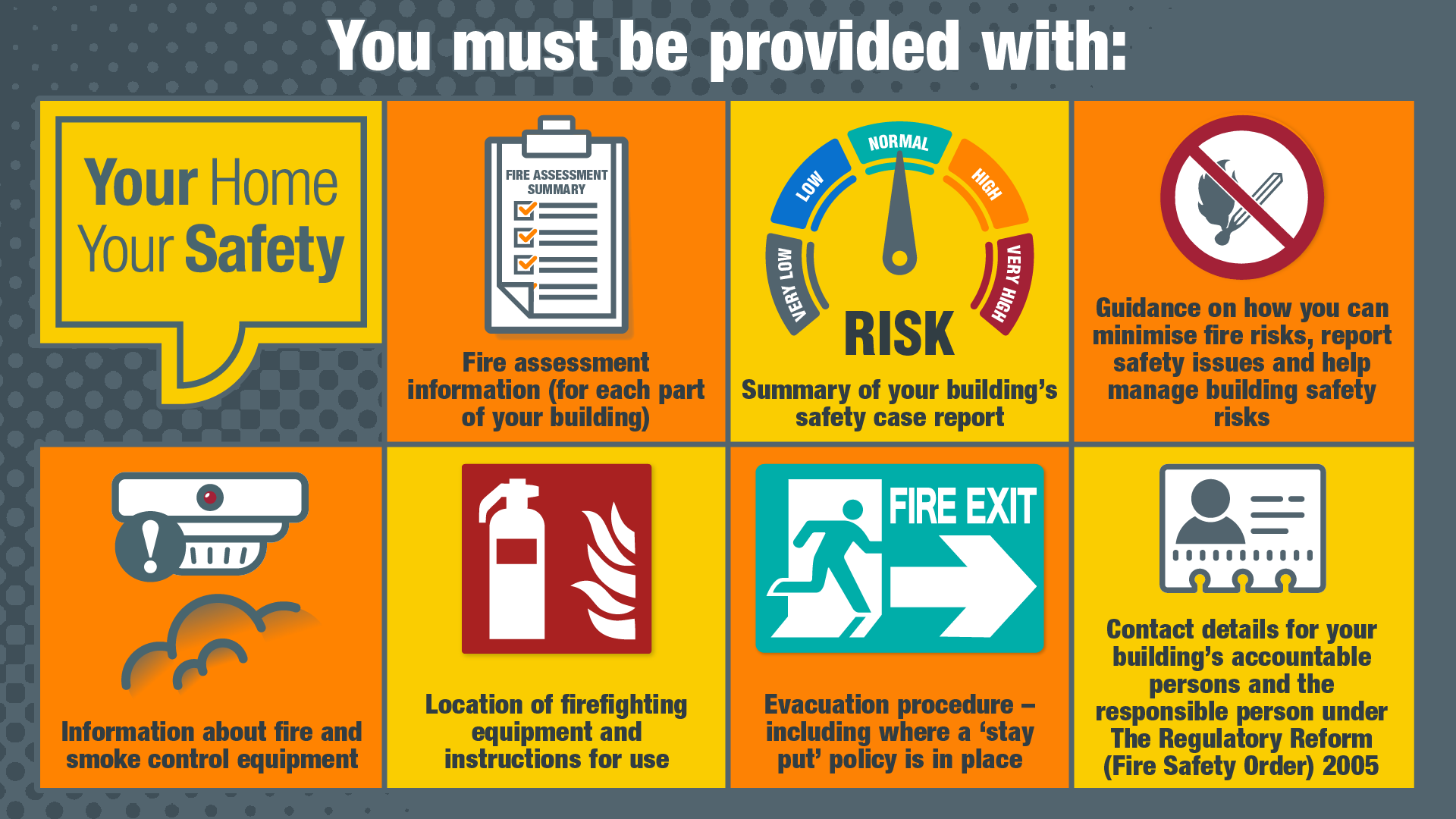Welcome to our ‘Your Home, Your Safety’ newsletter for people living in high-rise buildings in England.1
Here you will find more detail on how changes to building safety laws benefit you.
You can also revisit our ‘Your Home, Your Safety’ page for an overview of what’s changing and why.
We want you to be safe and feel safe in your home.

Your voice matters
You have a right to be involved in decisions about building safety issues that affect your home.
All high-rise residential buildings in England must be safe to live in. This means the risks of spread of fire and structural failure must be carefully managed.
Your building may have managing agents and building managers who look after it day-to-day.
It will also have a Principal Accountable Person (PAP) and Accountable Persons (APs). These are legal terms. The PAP is more likely to be an organisation than a person.
Your building’s APs and PAP have a legal responsibility to keep your building safe.
PAPs must also register it with the Building Safety Regulator (BSR).
The PAP must also produce and submit a safety case report about the building when BSR requests it. This report identifies safety risks and demonstrates how they are managing them.
Your building’s APs need to have a plan in place for keeping you informed about the safety of your building. You might hear this referred to as a ‘residents engagement strategy’.
They should make it clear how you can get involved in decisions about the safety of your building. They should also tell you how to raise concerns or complaints about safety issues.
Two-way engagement between residents and their building’s APs is crucial. This should help resolve any issues and make sure everyone feels safe in their own homes.
BSR also has a Residents’ panel to ensure people living in high-rise buildings are placed at the heart of the new regulatory regime.
Read more about the residents’ panel.
Listen to members of BSR’s residents’ panel on the importance of making sure everyone’s voice is heard
Watch and read examples of how APs have engaged with their residents
Read a transcript of this video

What else can you expect from your building’s APs?
Your building’s APs are there to help you, it is important to let them know what you need.
If you have individual needs relating to living safely in your building you should let your APs know so they can help.
You can check who the APs are and how to contact them by checking the high-rise building register.
In the future, you will be able to find this information on your Building Assessment Certificate (BAC).
The BAC must be visibly displayed in the building after it has been awarded by BSR.
The APs must provide you with information about how they are managing your building’s safety:


How you can play your part
You now have more rights as a high-rise resident but you also need to play your part.
You can help to keep your building safe for everyone living in it by taking a few simple actions.
Make sure you know
Video transcript
Things you should know
What you need to do in the event of an emergency
How to report safety concerns
Where to find information about fire safety measure and structural safety
How to formulate an escape plan
Look out for things that might be dangerous and report them
Check your lease or rental agreement and act responsibly
Video transcript
Don’t create risks or hazards
Don’t remove or interfere with fire safety equipment
Don’t store personal items in communal areas
Don’t carry out building work without permission
Your building’s APs need to assess and manage building safety risks.
Sometimes they may need to ask you for information or even access your property to do this. For your safety, you should allow access if they request it.
Your lease or rental agreement may allow refurbishment or building work in your home. You should notify your APs of any planned work before it begins.

What the law requires
Earlier we introduced what you can expect from your building’s PAP and APs. This included what information they need to provide to you.
In summary, they have a legal responsibility to:
- register the building
- manage the risks from the spread of fire and structural failure
- report safety occurrences to BSR
- prepare a safety case, and when requested by BSR, submit a safety case report
- keep, maintain, and provide safety information about the building
- keep other key information about the building
- prepare and maintain a residents’ engagement strategy
- apply for a Building Assessment Certificate (BAC) when requested to do so by BSR
- display the BAC in the building after BSR has awarded it
Read more about what APs and PAPs must do in our guidance collection.
You can also check if your own building is registered
If you cannot find it on the register contact us

What we can do for you
We will listen to you and act upon your concerns.
BSR regulates building safety risks in tall buildings. These risks are spread of fire and structural failure.
Your building’s APs have a legal responsibility to manage these risks.
BSR will take action if they don’t.
If you have a concern about building safety risks in your building contact your PAP or APs first. They should tell you how you can raise concerns or complaints about safety issues.
Raising a building safety concern

Read our simple guide on how to raise a building safety concern.
If you still have concerns after reporting a building safety risk to your PAP or AP, you can contact us

Who else can help?
BSR regulates the risk of spread of fire and structural failure in tall buildings only.
You may need to raise other concerns about your building.
Use our contacts page and downloadable guide to help you identify appropriate organisations that can help.
The information provided will help you live safely in your high-rise building community.
If you are part of a resident management company, we will share more information on what that means for you soon.
Please share this newsletter with your fellow residents, and encourage them to sign up
Remember, if you need to you can contact us

- When we refer to tall or high-rise residential buildings, we mean buildings which are 18 metres or seven or more floors in height. These buildings are known as higher-risk buildings under the Building Safety Act 2022. ↩︎
